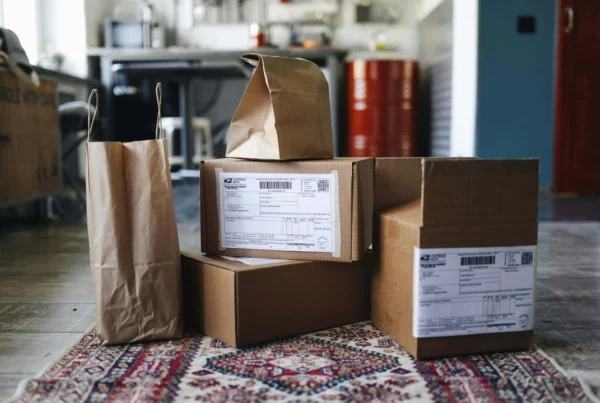Omnichannel retailers on the rise
While Amazon's share price grew at a slow pace before the Corona pandemic began, it increased by more than double within the last year and a half. eCommerce retailers are up and dominating the business field - not only in terms of market share but also in seamless customer experience across all channels and free product delivery. The numbers reflect the 2020 Christmas retail season: according to HDE/IfH Cologne, the online share increased by four percentage points year-over-year to 18.4%.
But appearances are deceptive. Although retailers have struggled in recent years to keep pace with the speed of deliveries from online-only retailers, the pure online players now see themselves in danger. Kurt Salmon of Accenture Strategy comes to the same conclusion in a recent study titled "Omnichannel-Fulfillment - Stationäre Händler holen gegenüber Pure eCom auf."
According to the study, retailers held back concerning their delivery promises this year and advised a whole 4.9 days (in contrast to achieved delivery times in 2017 of 3.1 and 2016 of 2.9 days). In contrast, 58% of retailers expanded their service offering to include three or more delivery options. These include packing stations, parcel stores, or in-store pickup.
Although in the apparel sector, the proportion of retailers offering click & collect as part of their service grew to 77%, the majority still have a stately delivery time of 4.4 days on average. Shipping to the store thus takes longer for the final consumer than having the items delivered to their home. Nevertheless, with an average of 4.6 days, the Pure eCom players do not seem to be able to compete against luxury brands (⊘ 2.3 days) and DIY stores (⊘ 2.6 days).
For brick-and-mortar retail, this type of retailing holds significant growth potential and the possibility of outstripping pure online businesses. However, a holistic approach is essential for this. The individual cost components and services must first be meticulously analyzed and evaluated before the subsequent optimization.
Advantages and disadvantages of pure-play and omnichannel eCommerce
Costs
Both players bear the costs of operating an online store. Pure play as well as omnichannel eCommerce companies, have to be prepared to pay for web hosting, web design, and order processing. In order for the website to be available to the customer, it is hosted on a server. One provider for all-in-one eCommerce platforms is, for instance, Shopify. Naturally, the website ought to be visually appealing and playfully navigable, so that website visitors convert to buying customers.
By contrast, warehouse space for goods and equipment can involve very high upfront costsand are difficult to scale. For this purpose, third-party logistics (3PL) suppliers serve as the ideal service provider for eCommerce merchants' orders by quoting different rates for fulfillment and storage. Pure play companies, in particular, can take advantage of this to reduce their hefty shipping costs through the networks. Meanwhile, there are ongoing rental and ancillary costs for the physical store, plus compensation and benefits for store employees. Thus, insofar as solely expenses are concerned, the advantage is on the pure-play side.
Digital customer experience
eCommerce pure players can devote their time and money to the web interface. On the other hand, omnichannel providers have to divide their resources between the physical store and the online shop. The design or UI (user interface) of the website plays a significant role in customer acquisition. However, the UX (user experience) is even more critical. If visitors do not find what they are looking for within a short time, they will exit the website and seek an alternative provider. Pure players should have an advantage here thanks to more experience in this area. However, omnichannel retailers can benefit from their know-how in preparing physical advertising material and applying these learnings to the online space.
General customer expectation
Although pure eShops can impress with a highly convenient online shopping experience, there are many advantages and disadvantages associated with this. For one thing, the consumer does not have the opportunity to physically inspect the goods before buying them and must rely on product reviews and pictures or videos. On the other hand, the final customer bypasses shipping and thus potential costs and delays when buying in brick-and-mortar stores. Thanks to the human interaction in the store, the consumer is also offered personal advice and direct contacts in the event of any problems.
Increasingly, eCommerce retailers are therefore turning to physical retail spaces in the form of concept stores. Amazon Go, for example, offers a checkout-free grocery store, while mattress company Casper plans to create 200 brick-and-mortar stores in 2021. This could be a wake-up call for pure players to open up further to the omnichannel business model and include it as an additional touchpoint on the customer journey.
Flexible fulfillment for a seamless customer journey
Click & Meet, Reserve & Collect, Return-to-Store are just some of the buzzwords that have emerged during the last few years as new services in stationary retail. Therefore, retailers are constantly faced with the challenge to seamlessly fulfill the customer's requirements on every sales channel in order to make the product available to him/her at any time, at any place, and in any version.
Once the barrier between store operator and fulfiller softens and omnichannel fulfillment is in place, ensuring flexibility while maintaining reliability and predictability is paramount. To guarantee that the end customer receives his/her goods in a defined time window at the desired location in a predefined condition, the store must be fully networked with the fulfillment service provider via real-time inventories in the warehouse management system (WMS). In addition, the newly created processes must be integrated into personnel planning as well as in the store process.
It is a top priority for brick-and-mortar retailers and online stores to deliver on the service promises made to customers. Therefore, reliable fulfillment providers are necessary who offer customized fulfillment services and meet the product and service expectations accordingly to the fullest satisfaction.
USP through diversification in logistics
To react quickly to different market conditions and minimize the risk of being affected by failures in times of crisis, diversification in logistics can be the aim. A broad range of parcel suppliers and fulfillment service providers with multiple locations offers flexibility and room for maneuver to make ideal use of free capacities in the event of bottlenecks. Warehousing1 offers the seamless technical connection WH1+for this purpose. The tailor-made dashboard provides the optimal overview of individual KPIs: For example, the user receives insights on return reasons and quantities and is automatically warned about low stock levels.
Bundled with levers such as Click & Collect, vendors can specifically differentiate themselves from the competition and increase the frequency of visits as well as the desire to visit the branch - especially in the case of in-house commissioning. The only prerequisite: availability of the goods for collection within a few hours.
If you want to learn how to manage your fulfillment and warehouse logistics digitally via a central platform, expand it flexibly and optimize it efficiently, contact us!



